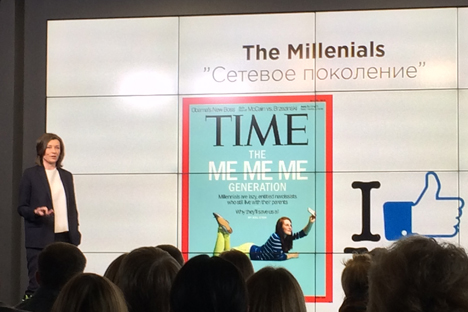
The famous Time magazine's cover illustrating the MeMeMe generation. Source: Vsevolod Pulya
The new generation of self-centered consumers was the main focus of discussion during the fifth annual Condé Nast Digital Day. The international professional conference for digital marketers was held in Moscow on April 10.
According to Luca Dini, editor-in-chief of Vanity Fair magazine, who gave a speech at CNDD, the main emotion guiding followers of fashion bloggers today can be defined as “me too”. These millenials aspire to be part of the hedonistic community and just enjoy their lives.
“The modern audience is much faster and fresher. They express themselves with Instagram and other social media,” said Mr Dini. Instead of being rational about their purchases, they act according to the logic “I like it and I want it”. Dini noted that user reviews don’t mean much to these consumers, and they have money to spend on themselves.
“They are self-centered, but that’s their strength,” said Dini.
Anita Gigovskaya, CEO of Conda Nast Russia, also touched upon the changing nature of the consumer in her opening speech. She pointed out the rise of “yummies”, (an abbreviation for “young urban males”), among other millenials. These new young men, ranging from 20 to 30 in age, represent an upgraded version of metrosexuals. They live in big cities, like to dress with style, and spend lots of money on their appearance. This trend is very prominent in Asian countries and is increasingly popular among young Russians - as opposed to Europe’s recent passion for “normcore”, a new cultural trend that celebrates the idea of maintaining a modest and practical lifestyle or just “being normal” like everybody else.
To the awe of the members of the so-called “MeMeMe generation” who attended the CNDD, there was a special spot in the hall for taking selfies - with a logo of the conference projected on your face.
Making money on millenials
However, Condé Nast Digital Day is not just about discussing social trends - it’s more about making money out of them.
E-commerce and improving the prominence of the company’s internet presence were stated as one of the most obvious opportunities for luxury brands. Robert Triefus, chief marketing officer for Gucci, pointed out that online shopping remains an unexplored realm for luxury brands, which still rely on offline shopping – ironically, as many luxury customers have made their distaste for shopping in public abundantly clear.
“Customers don’t like the idea of being judged on their appearance. Sometimes they want to go shopping for luxury items dressed in sportswear or hoodies,” said Triefus. Gucci statistics show the changing nature of its customers: Eighty percent do their shopping exclusively offline, 5 percent shop only via the internet, and the remaining 15 percent do both.
The influence of e-commerce also extends to shop assistants. Fadi Shuman, CEO and founder of e-commerce solutions company Pod1, showed an online shop created for one of its clients that allows customers to virtually try on garments and combine different items to create various looks- and then purchase them together in one click. This slick feature was great for online consumers, but diminished the role of shop assistants. So Shuman suggested they give out iPads with the website to shop assistants who could use them in the company’s brick-and-mortar stores and remain part of the process of selecting the right outfit.
“Nowadays the line between online and offline shopping experiences is blurring,” concluded Shuman.
E-commerce growth and threats
The Russian e-commerce market is growing rapidly - in 2013 it grew 13 percent to an already significant $17 billion, according to a recent report by the Russian Association of Internet Companies (AKIT). There are more than 30,000 online shops operating in Russia, and 30 million Russians are shopping online.
One of the threats that accompanies this rapid growth is the abundance of counterfeit goods. During Conde Nast Digital Day, Ilya Sachkov, CEO of Group IB, told the story of Leo Kuvayev, one of the world’s top 8 spammers. Some five years ago Kuvayev created a network of phishing websites which were designed to resemble those of major e-commerce players. He sent out millions of spam emails to attract customers to these websites, which in fact sold counterfeit products: prescription drugs, bags and illegal software that was mailed by post on CDs.
In 2012 Kuvayev was found guilty in Moscow, but the conviction related to sexual molestation charges, not to his internet crimes.
According to Sachkov, a lot of illegal internet commerce is still escaping detection by Russian law-enforcement institutions. To prove his point, Sachkov recounted the story of how he had once ordered a delivery of cocaine and LSD at underground online store Silk Road. The order was mailed via Russian Post directly to the office of the FSKN (Russian Federal Drug Control Service).
It’s not only about drugs and guns - some communities on Russian social networks sell counterfeit copies of luxury brand items. “This is a warning for all brands: Soon you may be facing it as a big problem,” noted Sachkov.
All rights reserved by Rossiyskaya Gazeta.
Subscribe
to our newsletter!
Get the week's best stories straight to your inbox